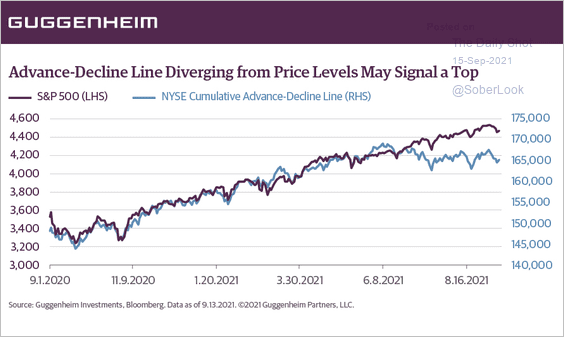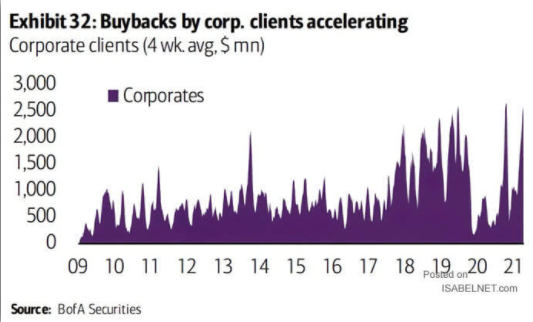As we suspected investors showed up to BTFD but will it stick?
At a mere 10 points above the 50 dma animal spirits were ignited yesterday. Does yesterday’s bounce signal record highs are straight ahead or is it fools gold? At yesterday’s close, the S&P was only 70 points below the recent all-time high of 4550. The 50 dma sits below at 4430.
Unlike prior BTFD’s in the last few months, equity markets are opening slightly lower, and foreign markets are not jumping on the BTFD bandwagon. Further pressuring confidence, China’s largest real estate developer, Evergrande, is suspending trading in its bonds today. They have over $300 billion in debt outstanding. It is unclear whether the Chinese government will bail out shareholders.

What To Watch Today
Economy
- 8:30 a.m. ET: Retail Sales Advance, month-over-month, August (-0.7% expected, -1.1% in July)
- 8:30 a.m. ET: Retail Sales excluding autos and gas, August (unchanged expected, -0.7% in July)
- 8:30 a.m. ET: Initial jobless claims, week ended Sept. 11 (323,000 expected, 310,000 during prior week)
- 8:30 a.m. ET: Continuing Claims, week ended Sept. 4 (2.740 million expected, 2.783 million during prior week)
- 8:30 a.m. ET: Philadelphia Fed Business Outlook Index, September (19.0 expected, 19.4 in August)
- 10:00 a.m. ET: Business inventories, July (0.5% expected, 0.8% in June)
- 4:00 p.m. ET: Total Net TIC Flows, July ($31.5 billion in June)
- 4:00 p.m. ET: Net long-term TIC Flows, July ($110.9 billion in June)
Earnings
- No notable reports scheduled for release
Courtesy of Yahoo!
Investors BTFD
As has been the pattern as of late, investors showed up yesterday to once again “BTFD.” As we have noted over the past few reports this activity has become almost clock work with declines bottoming during options expiration week.
During the recent “market crash” of nearly 2%, the slow decline, and heavy sector rotation, worked off the previously overbought condition (top panel.) That oversold condition has consistently provided the fuel necessary for a short-term bounce. With strong support at the 50-dma, the bounce was not unexpected as we discussed in this past weekend’s newsletter:
“With sell signals in place, volume rising, and breadth weak, a retest of the 50-dma early next week will not be a surprise. The question will be whether traders show up again, as they have done every other time over the last 6-months to “buy the dip.”

The question, as noted above, is the bounce yesterday a signal to jump in with markets running back to all-time highs? Or, will the internal deterioration of the markets finally play catchup?

Buyback Support
One of the biggest supports for asset prices this year remains corporate share repurchases. As companies are sitting on a mountain of cash, with few options to deploy it, the most beneficial use of corporate coffers for insiders are share buybacks.

If you think the share buybacks are a “return of cash to shareholders” you need to read this:
Trouble in China?
Stringent lockdowns and political pressures are showing up in China’s economic data. For example, YoY growth in retail sales fell to 2.5% in August versus the estimate of 7% from a Bloomberg survey of economists. Furthermore, construction investment is down 3.2% YTD following China’s new property restrictions, which is impacting global demand for commodities. For example, Chinese steel output is at a 17-month low in August according to Bloomberg. China’s government avoided broad stimulus to support economic recovery, but some economists believe conditions will ease on margin moving forward due to slowing growth.

Can “Buy The Dippers” Drive Markets Higher?

Apple Has No Inflation
A great quote from Yahoo this morning following yesterday’s “Apple Product Release” day.
“CNBC’s Jon Fortt astutely observed that the House that Steve Jobs built opted to keep prices at iPhone 12 levels — effectively making the iPhone “inflation-proof.”
Back in 2011, then-New York Federal Reserve President William Dudley attempted to reassure Queens consumers about spiking food prices. The central banker cited the latest iPad that cost the same as the prior version as a reason why “you have to look at the prices of all things.”
As one can imagine, the analogy went down badly with Dudley’s working-class audience. One attendee tossed out a memorably biting quip: “I can’t eat an iPad.”
A decade later, it suffices to say that iPads — or iPhones — still aren’t edible. Policymakers would do well to remember that.
Praseodymium and Neodymium Prices are Soaring
Why should I care about the prices of materials I have never heard of, you might be asking. These largely unknown metals and other are worsening supply delays and causing inflation in many popular technology goods. “Tech industry braces for skyrocketing rare earth prices” by NikkeiAsia, discusses why the prices of many rare earth materials are surging and the effect it’s having on tech manufacturers.
Per the article:“Praseodymium and neodymium belong to a category of metals known as rare-earth elements and are used to make neodymium-iron-boron (NdFeB) magnets. These permanent magnets, as they are known, are essential to a swath of tech gear — everything from speakers and electric vehicle motors to medical devices and precision munitions.”

Peaking Natural Gas Prices?
On Monday we pointed out natural gas prices are broaching the upper band of its ten-year range. Forex Live has interesting commentary arguing there may be more gains to come. For support, they cite the TD Securities graph below showing gas storage versus demand is at record lows (outside of the green band). It is also well below the recent five-year average. They think many analysts focus too much on the supply of gas and not enough on demand. Per the article, demand is picking up for the following reasons: “What that ignores is that demand for natural gas has grown considerably in the past five years. The construction of many LNG facilities, the conversion of coal-fired power plants to natural gas and pipelines to Mexico all mean that larger inventories are needed.” Further: “What’s especially worrisome is that there are no signs of increased drilling.“

Peaking Delta?
Quite a few Fed members mention the Delta variant as a reason they should delay tapering. John Hussman’s model below expects fatalities from Delta to peak in the coming weeks. Assuming his model holds up, as it has, the number of fatalities should hopefully drop significantly into November and December. Accordingly, it should alleviate concerns from some Fed members.

Also Read

















